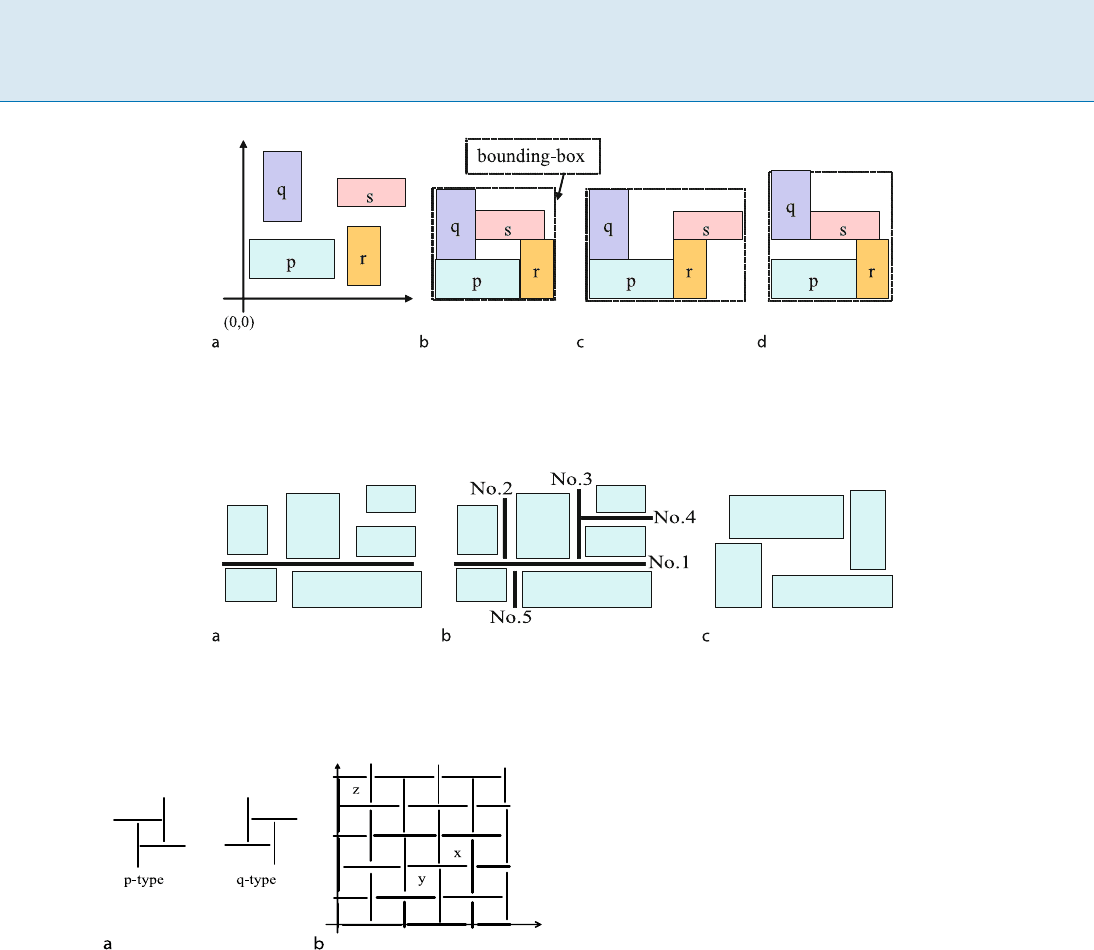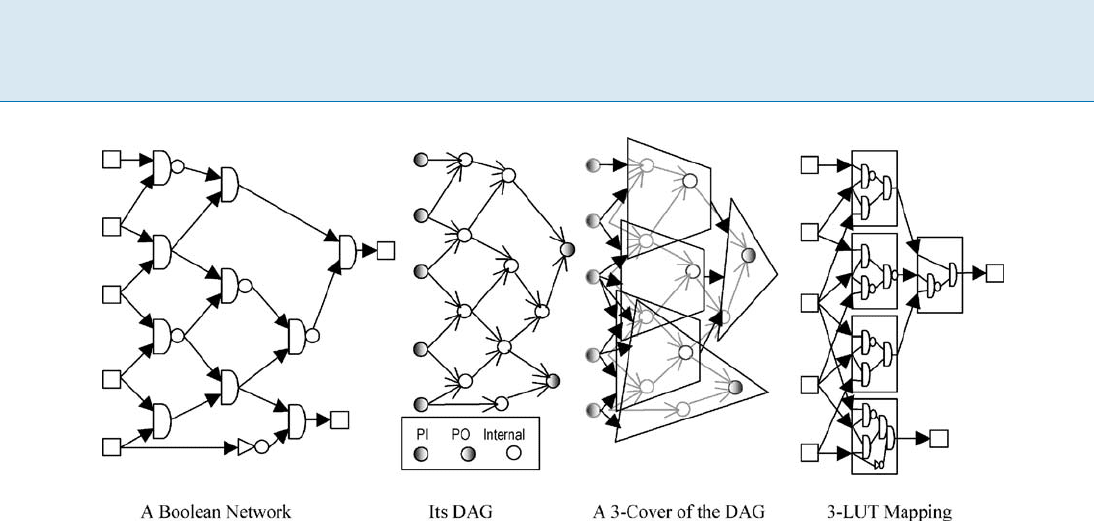Kao M.-Y. (ed.) Encyclopedia of Algorithms
Подождите немного. Документ загружается.


318 F Floorplan and Placement
Floorplan and Placement, Figure 1
a A feasible placement whose ABLR-relations could be observed differently. b Compacted placement if ABLR-relations are (qLr),
(sAp), . . . . Its Sequence-Pair is SP = (qspr,pqrs) and Single-Sequence is SS = (2413). c Compacted placement for (qLr), (sRp), . . . .
SP = (qpsr,pqrs). SS = (2143). d Compacted placement if (qAr), (sAp), . . . . SP = (qspr,prqs). SS = (3412)
Floorplan and Placement, Figure 2
a A placement with a slice-line. b A slicing structure since a slice-line can be found in each ith hierachy No. k(k =1; 2; 3; 4). c Aplace-
ment that has no slice-line
Floorplan and Placement, Figure 3
a Two types of the spiral structure (2) 5 5p-type Bounded-
Sliceline-Grid (BSG)
is above room y. Furthermore, Transitive-Law is assumed:
If “x is above y” and “z is above x”, then “z is above y”.
Other relations are analogously defined.
Lemma 1 A room is in a unique ABLR-relation with every
other room.
An n n BSG has n
2
rooms. A BSG-assignment is a one-
to-one mapping of n objects into the rooms of n n BSG.
(n
2
n rooms remain vacant.)
After a BSG-assignment, a pair of two objects inher-
its the same ABLR-relation as the ABLR-relation defined
between corresponding rooms. In Fig. 3,ifx,y,andzare
the names of objects, are ABLR-relations among them as
f(xAy); (xRz); (yBx); (yBz); (zLx); (zAy)g.
Key Results
The input is n objects that are rectangles of arbitrary sizes.
The main concern is the solution space, the collection of
distinct consistent ABLR-relation sets, to be generated by
BSG or SP.
Theorem 2 ([4,5])
1) For any feasible ABLR-relation set, there is a BSG-as-
signment into n n BSG of any type that generates the
same ABLR-relation set.
2) The size n n is a minimum: if the number of rows or
columns is less than n, there is a feasible ABLR-relation
set that is not obtained by any BSG-assignment.
The proof to 1) is not trivial [5](Appendix). The number
of solutions is
n
2
C
n
. A remarkable feature of an n n BSG
is that any ABLR-relation set of n objects is generated by
a proper BSG-assignment. By this property, BSG is said to
be universal [11].
In contrast to the BSG-based generation of consistent
ABLR-relation sets, SP directly imposes the ABLR-rela-
tions on objects.

Floorplan and Placement F 319
A pair of permutations of object names, represented as
(
+
,
), is called the Sequence-Pair, or SP. See Fig. 1.
An SP is decoded to a unique ABLR-relation set by the
rule:
Consider a pair (x, y) of names such that x is before y
in
.Then(xLy)or(xAy)ifx is before or after y in
+
,
respectively. ABLR-relations “B”and“R” can be derived as
the inverse of “A” and “L”. Examples are given in Fig. 1.
A remarkable feature of Sequence-Pair is that its gen-
erationanddecodingarebothpossiblebysimpleopera-
tions. The question is what the solution space of all SP’s
is
Theorem 3 Any feasible placement has a corresponding SP
that generates an ABLR-relation set satisfied by the place-
ment. On the other hand, any SP has a corresponding place-
ment that satisfies the ABLR-relation set derived from the
SP.
Using SP, a common compaction technique mentioned
before is described in a very simple way:
Minimum Area Placement from SP =(
+
,
)
1. Relabel the objects such that
=(1; 2;:::;n). Then
+
=(p
1
; p
2
;:::;p
n
) will be a permutation of num-
bers 1; 2;:::;n. It is simply a kind of normalization
of SP [10]. But Kajitani [11] considers it a concept de-
rived from Q-sequence [9] and studies its implication
bythenameofSingle-Sequence or SS.Intheexamplein
Fig. 1b, p, q, r, and s are labeled as 1, 2, 3, and 4 so that
SS = (2413).
2. Take object 1 and place it at the left-bottom corner in
the 1st quadrant.
3. For k =2; 3;:::;n,placek such that its left edge is at
the rightmost edge of the objects with smaller numbers
than k and lie before k in SS,anditsbottomedgeisat
the topmost edge of the objects with smaller numbers
than k and lie after k in SS.
Applications
Many ideas followed after BSG and SP [2,3,4,5] as seen in
the reference. They all applied a common methodology of
a stochastic heuristic search, called Simulated Annealing,
to generate feasible placements one after another based
on some evaluation (with respect to the smallness of the
bb-area), and to keep the best-so-far as the output. This
methodology has become practical by the speed achieved
duetotheirsimpledatastructure.Thefirstandnaiveim-
plementation of BSG [2] could output the layout of suffi-
ciently small area placement of five hundred rectangles in
several minutes. (Finding a placement with the minimum
bb-area is NP-hard [3].) Since then many ideas followed,
including currently widely used codes such as O-tree [6],
B*-tree [8], Corner–Block–List [7], Q-sequence [9], Sin-
gle-Sequence [11], and others. Their common feature is
in coding the nonoverlapping constraint along horizontal
and vertical directions, which is the inheritant property of
rectangles.
As long as applications are concerned with the rectan-
gle placement in the minimum area, and do not mind mu-
tual interconnection, the problem can be solved practically
enough by BSG, SP, and those related ideas. However, in
an integrated circuit layout problem, mutual connection
is a major concern. Objects are not restricted to rectan-
gles, even soft objects are used for performance. Many ef-
forts have been devoted with a certain degree of success.
For example, techniques concerned with rectilinear ob-
jects, rectilinear chip, insertion of small but numerous ele-
ments like buffers and decoupling capacitors, replacement
for design change, symmetric placement for analog cir-
cuit design, 3-dimensional placement, etc. have been de-
veloped. Here few of them is cited but it is recommended
to look at proceedings of ICCAD, DAC, ASPDAC, DATE,
and journals TCAD, TCAS, particularly those that cover
VLSI physical design.
Open Problems
BSG
The claim of Theorem 2 that a BSG needs n rows to pro-
vide any feasible ABLR-relation set is reasonable if consid-
ering a placement of all objects aligned vertically. This is
due to the rectangular framework of a BSG. However, ex-
periments have been suggesting a question if from the be-
ginning [5] if we need such big BSGs. The octagonal BSG is
defined in Fig. 4. It is believed to hold the following claim
expecting a drastic reduction of the solution space.
Floorplan and Placement, Figure 4
Octagonal BSG of size n, p-type: a If n is odd, it has (n
2
+1)/2
rooms. b If n is even, it has (n
2
+2n)/2 rooms

320 F Flow Time Minimization
Conjecture (BSG): For any feasible ABLR-relation set,
there is an assignment of n objects into octagonal BSG of
size n, any type, that generates the same ABLR-relation set.
If this is true, then the size of the solution space needed
by a BSG reduces to
(n
2
+1)/2
C
n
or
(n
2
+2n)/2
C
n
.
SP or SS
It is possible to define the universality of SP or SS in
the same manner as defined for BSG. In general, two
sequences of arbitrary k numbers P =(p
1
; p
2
;:::;p
k
)
and Q=(q
1
; q
2
;:::;q
k
)aresaidsimilar with each other
if ord(p
i
)=ord(q
i
) for every i where ord(p
i
)=j implies
that p
i
is the jth smallest in the sequence. If they are single-
sequences, two similar sequences generate the same set of
ABLR-relations under the natural one-to-one correspon-
dence between numbers.
An SS of length m (necessarily n)issaiduniversal of
order n if SS has a subsequence (a sequence obtained from
SS by deleting some of the numbers) that is similar to any
sequence of length n. Since rooms of a BSG are considered
n
2
objects, Theorem 2 implies that there is a universal SS of
order n whose length is n
2
. The known facts about smaller
universal SS are:
1. For n =2; 132; 231; 213, and 312 are the shortest uni-
versal SS. Note that 123 and 321 are not universal.
2. For n =3; SS = 41352 is the shortest universal SP.
3. For n = 4, the shortest length of universal SS 10 or less.
4. The size of universal SS is ˝(n
2
)[12].
Open Problem (SP)
It is still an open problem to characterize the universal SP.
For example, give a way to 1) certify a sequence as uni-
versal and 2) generate a minimum universal sequence for
general n.
Cross References
Bin Packing
Circuit Placement
Slicing Floorplan Orientation
Sphere Packing Problem
Recommended Reading
1. Wong, D.F., Liu, C.L.: A new algorithm for floorplan design. In:
ACM/IEEE Design Automation Conference (DAC), November
1985, 23rd, pp. 101–107
2. Nakatake, S., Murata, H., Fujiyoshi, K., Kajitani, Y.: Bounded
Sliceline Grid (BSG) for module packing. IEICE Technical Re-
port, October 1994, VLD94-66, vol. 94, no. 313, pp. 19–24 (in
Japanese)
3.Murata,H.,Fujiyoshi,K.,Nakatake, S., Kajitani, Y.: A solu-
tionspaceofsize(n!)
2
for optimal rectangle packing. In: 8th
Karuizawa Workshop on Circuits and Systems, April 1995,
pp. 109–114
4. Murata, H., Nakatake, S., Fujiyoshi, K., Kajitani, Y.: VLSI Module
placement based on rectangle-packing by Sequence-Pair. IEEE
Trans. Comput. Aided Design (TCAD) 15(12), 1518–1524 (1996)
5. Nakatake, S., Fujiyoshi, K., Murata, H., Kajitani, Y.: Module pack-
ing based on the BSG-structure and IC layout applications. IEEE
TCAD 17(6), 519–530 (1998)
6. Guo, P.N., Cheng, C.K., Yoshimura, T.: An O-tree representation
of non-slicing floorplan and its applications. In: 36th DAC., June
1998, pp. 268–273
7. Hong, X., Dong, S., Ma, Y., Cai, Y., Cheng, C.K., Gu, J.: Cor-
ner Block List: An efficient topological representation of non-
slicing floorplan. In: International Computer Aided Design (IC-
CAD) ’00, November 2000, pp. 8–12,
8. Chang, Y.-C., Chang, Y.-W., Wu, G.-M., Wu, S.-W.: B*-trees: A new
representation for non-slicing floorplans. In: 37th DAC, June
2000, pp. 458–463
9. Sakanushi, K., Kajitani, Y., Mehta, D.: The quarter-state-
sequence floorplan representation. In: IEEE TCAS-I: 50(3), 376–
386 (2003)
10. Kodama, C., Fujiyoshi, K.: Selected Sequence-Pair: An effi-
cient decodable packing representation in linear time using
Sequence-Pair. In: Proc. ASP-DAC 2003, pp. 331–337
11. Kajitani, Y.: Theory of placement by Single-Sequence Realted
with DAG, SP, BSG, and O-tree. In: International Symposium on
Circuts and Systems, May 2006
12. Imahori, S.: Privatre communication, December 2005
Flow Time Minimization
2001; Becchetti, Leonardi,
Marchetti-Spaccamela, Pruhs
LUCA BECCHETTI
1
,STEFANO LEONARDI
1
,
A
LBERTO MARCHETTI-SPACCAMELA
1
,KIRK PRUHS
2
1
Department of Information and Computer Systems,
University of Rome, Rome, Italy
2
Computer Science, University of Pittsburgh,
Pittsburgh, PA, USA
Keywords and Synonyms
Flow time: response time
Problem Definition
Shortest-job-first heuristics arise in sequencing problems,
when the goal is minimizing the perceived latency of users
of a multiuser or multitasking system. In this problem, the
algorithm has to schedule a set of jobs on a pool of m iden-
tical machines. Each job has a release date and a processing
time, and the goal is to minimize the average time spent by
jobs in the system. This is normally considered a suitable
measure of the quality of service provided by a system to

Flow Time Minimization F 321
interactive users. This optimization problem can be more
formally described as follows:
Input Asetofm identical machines and a set of n jobs
1; 2;:::;n. Every job j has a release date r
j
and a processing
time p
j
.Inthesequel,I denotes the set of feasible input
instances.
Goal The goal is minimizing the average flow (also
known as average response)timeofthejobs.LetC
j
de-
note the time at which job j is completed by the system.
The flow time or response time F
j
of job j is defined by
F
j
= C
j
r
j
. The goal is thus minimizing
min
1
n
n
X
j=1
F
j
:
Since n is part of the input, this is equivalent to minimizing
the total flow time, i. e.
P
n
j=1
F
j
.
Off-line versus on-line In the off-line setting,thealgo-
rithm has full knowledge of the input instance. In particu-
lar, for every j =1;:::;n,thealgorithmknowsr
j
and p
j
.
Conversely, in the on-line setting,atanytimet,the
algorithm is only aware of the set of jobs released up to
time t.
In the sequel, A and OPT denote, respectively, the al-
gorithm under consideration and the optimal, off-line pol-
icy for the problem. A(I)andOPT(I) denote the respective
costs on a specific input instance I.
Further assumptions in the on-line case Further as-
sumptions can be made as to the algorithm’s knowledge
of processing times of jobs. In particular, in this survey
an important case is considered, realistic in many appli-
cations, i. e. that p
j
is completely unknown to the on-line
algorithms until the job eventually completes (non-clair-
voyance)[1,3].
Performance metric In all cases, as is common in com-
binatorial optimization, the performance of the algorithm
is measured with respect to its optimal, off-line counter-
part. In a minimization problem such as those considered
in this survey, the competitive ratio
A
is defined as:
A
=max
I2I
A(I)
OPT(I)
:
In the off-line case,
A
is the approximation ratio of
the algorithm. In the on-line setting,
A
is known as the
competitive ratio of A.
Preemption When preemption is allowed, a job that is
being processed may be interrupted and resumed later af-
ter processing other jobs in the interim. As shown further,
preemption is necessary to design efficient algorithms in
the framework considered in this survey [5,6].
Key Results
Algorithms
Consider any job j in the instance and a time t in A’s sched-
ule, and denote by w
j
(t) the amount of time spent by A
on job j until t.Denotebyx
j
(t)=p
j
w
j
(t)itsremaining
processing time at t.
The best known heuristic for minimizing the average
flow time when preemption is allowed is shortest remain-
ing processing time (SRPT). At any time t,SRPTexecutes
apendingjobj such that x
j
(t) is minimum. When preemp-
tion is not allowed, this heuristic translates to shortest job
first (SJF): at the beginning of the schedule, or when a job
completes, the algorithm chooses a pending job with the
shortest processing time and runs it to completion.
Complexity
The problem under consideration is polynomially solvable
on a single machine when preemption is allowed [9,10].
When preemption is allowed, SRPT is optimal for the
single-machine case. On parallel machines, the best
known upper bound for the preemptive case is achieved
by SRPT, which was proven to be O(log min n/m; P)-
approximate [6], P being the ratio between the largest
and smallest processing times of the instance. Notice that
SRPT is an on-line algorithm, so the previous result holds
fortheon-linecaseaswell.Theauthorsof[6]alsoprove
that this lower bound is tight in the on-line case. In the
off-line case, no non-constant lower bound is known when
preemption is allowed.
Inthenon-preemptivecase,nooff-linealgorithmcan
be better than ˝(n
1/3
)-approximate, for every >0, the
best upper bound being O(
p
n/m log(n/m)) [6]. The up-
perandlowerboundbecomeO(
p
n)and˝(n
1/2
)for
the single machine case [5].
Extensions Many extensions have been proposed to the
scenarios described above, in particular for the preemp-
tive, on-line case. Most proposals concern the power of the
algorithm or the knowledge of the input instance. For the
former aspect, one interesting case is the one in which the
algorithm is equipped with faster machines than its opti-
mal counterpart. This aspect has been considered in [4].
There the authors prove that even a moderate increase

322 F Formal Methods
in speed makes some very simple heuristics have perfor-
mances that can be very close to the optimum.
As to the algorithm’s knowledge of the input instance,
an interesting case in the on-line setting, consistent with
many real applications, is the non-clairvoyant case de-
scribed above. This aspect has been considered in [1,3].
In particular, the authors of [1] proved that a random-
ized variant of the MLF heuristic described above achieves
a competitive ratio that in the average is at most a polylog-
arithmic factor away from the optimum.
Applications
The first and traditional field of application for schedul-
ing policies is resource assignment to processes in mul-
titasking operating systems [11]. In particular, the use of
shortest-job-like heuristics, notably the MLF heuristic, is
documented in operating systems of wide use, such as
UNIX and WINDOWS NT [8,11]. Their application to
other domains, such as access to Web resources, has been
considered more recently [2].
Open Problems
Shortest-job-first-based heuristics such as those consid-
ered in this survey have been studied in depth in the re-
cent past. Still, some questions remain open. One concerns
the off-line, parallel-machine case, where no non-constant
lower bound on the approximation is known yet. As to
the on-line case, there still is no tight lower bound for
the non-clairvoyant case on parallel machines. The cur-
rent ˝(log n) lower bound was achieved for the single-
machine case [7], and there are reasons to believe that it
is below the one for the parallel case by a logarithmic fac-
tor.
Cross References
Minimum Flow Time
Minimum Weighted Completion Time
Multi-level Feedback Queues
Shortest Elapsed Time First Scheduling
Recommended Reading
1. Becchetti, L., Leonardi, S.: Nonclairvoyant scheduling to min-
imize the total flow time on single and parallel machines.
J. ACM 51(4), 517–539 (2004)
2. Crovella, M.E., Frangioso, R., Harchal-Balter, M.: Connection
scheduling in web servers. In: Proceedings of the 2nd USENIX
Symposium on Internet Technologies and Systems (USITS-99),
1999 pp. 243–254
3. Kalyanasundaram, B., Pruhs, K.: Minimizing flow time nonclair-
voyantly. J. ACM 50(4), 551–567 (2003)
4. Kalyanasundaram, B., Pruhs, K.: Speed is as powerful as clair-
voyance. J. ACM 47(4), 617–643 (2000)
5. Kellerer, H., Tautenhahn, T., Woeginger, G.J.: Approximability
and nonapproximability results for minimizing total flow time
on a single machine. In: Proceedings of 28th Annual ACM Sym-
posium on the Theory of Computing (STOC ’96), 1996, pp. 418–
426
6. Leonardi, S., Raz, D.: Approximating total flow time on parallel
machines. In: Proceedings of the Annual ACM Symposium on
the Theory of Computing STOC, 1997, pp. 110–119
7. Motwani,R.,Phillips,S.,Torng,E.:Nonclairvoyantscheduling.
Theor. Comput. Sci. 130(1), 17–47 (1994)
8. Nutt, G.: Operating System Projects Using Windows NT. Addi-
son-Wesley, Reading (1999)
9. Schrage, L.: A proof of the optimality of the shortest remaining
processing time discipline. Oper. Res. 16(1), 687–690 (1968)
10. Smith, D.R.: A new proof of the optimality of the shortest re-
maining processing time discipline. Oper. Res. 26(1), 197–199
(1976)
11. Tanenbaum, A.S.: Modern Operating Systems. Prentice-Hall,
Englewood Cliffs (1992)
Formal Methods
Learning Automata
Symbolic Model Checking
FPGA Technology Mapping
1992; Cong, Ding
JASON CONG
1
,YUZHENG DING
2
1
Department of Computer Science, UCLA,
Los Angeles, CA, USA
2
Synopsys Inc., Mountain View, CA, USA
Keywords and Synonyms
Lookup-Table Mapping; LUT Mapping; FlowMap
Problem Definition
Introduction
Field Programmable Gate Array (FPGA) is a type of inte-
grated circuit (IC) device that can be (re)programmed to
implement custom logic functions. A majority of FPGA
devices use lookup-table (LUT) as the basic logic element,
where a LUT of K logic inputs (K-LUT) can implement
any Boolean function of up to K variables. An FPGA
also contains other logic elements, such as registers, pro-
grammable interconnect resources, and input/output re-
sources [5].

FPGA Technology Mapping F 323
The programming of an FPGA involves the transfor-
mation of a logic design into a form suitable for imple-
mentation on the target FPGA device. This generally takes
multiple steps. For LUT based FPGAs, technology map-
ping is to transform a general Boolean logic network (ob-
tained from the design specification through earlier trans-
formations) into a functional equivalent K-LUT network
that can be implemented by the target FPGA device. The
objective of a technology mapping algorithm is to gener-
ate, among many possible solutions, an optimized one ac-
cording to certain criteria, some of which are: timing opti-
mization, which is to make the resultant implementation
operable at faster speed; area minimization, which is to
make the resultant implementation compact in size; power
minimization, which is to make the resultant implementa-
tion low in power consumption. The algorithm presented
here, named FlowMap [2], is for timing optimization; it
was the first provably optimal polynomial time algorithm
for technology mapping problems on general Boolean net-
works, and the concepts and approach it introduced has
since generated numerous useful derivations and applica-
tions.
Data Representation and Preliminaries
The input data to a technology mapping algorithm for
LUT based FPGA is a general Boolean network, which can
be modeled as a direct acyclic graph N =(V, E). A node
v 2 V can either represent a logic signal source from out-
side of the network, in which case it has no incoming edge
andiscalledaprimary input (PI) node; or it can represent
a logic gate, in which case it has incoming edge(s) from PIs
and/or other gates, which are its logic input(s). If the logic
output of the gate is also used outside of the network, its
node is a primary output (PO), which can have no outgo-
ing edge if it is only used outside.
If hu; vi2E; u is said to be a fanin of v,andv a fanout
of u. For a node v, input(v) denotes the set of its fanins;
similarly for a subgraph H, input(H) denotes the set of
distinct nodes outside of H that are fanins of nodes in H.
If there is a direct path in N from a node u to a node v,
u is said to be a predecessor
of v and v a successor of u.
The input network of a node v, denoted N
v
,isthesub-
graph containing v and all of its predecessors. A cone of
a non-PI node v, denoted C
v
,isasubgraphofN
v
contain-
ing v and possibly some of its non-PI predecessors, such
that for any node u 2 C
v
, there is a path from u to v in C
v
.
If jinput(C
v
)jK, C
v
is called a K-feasible cone. The net-
work N is K-bounded if every non-PI node has a K-feasible
cone. A cut of a non-PI node v is a bipartition (X, X
0
)of
nodes in N
v
such that X
0
is a cone of v; input(X
0
) is called
the cut-set of (X, X
0
), and n(X; X
0
)=jinput(X
0
)j the size
of the cut. If n(X; X
0
) K,(X, X
0
)isaK-feasible cut. The
volume of (X, X
0
)isvol(X; X
0
)=jX
0
j.
A topological order of the nodes in the network N is
a linear ordering of the nodes in which each node appears
after all of its predecessors and before any of its successors.
Such an order is always possible for an acyclic graph.
Problem Formulation
A K-cover of a given Boolean network N is a network
N
M
=(V
M
; E
M
), where V
M
consists of the PI nodes of N
and some K-feasible cones of nodes in N,suchthatfor
each PO node v of N, V
M
contains a cone C
v
of v;and
if C
u
2 V
M
, then for each non-PI node v 2 input(C
u
), V
M
also contains a cone C
v
of v.edgehu; C
v
i2E
M
if and only
if PI node u 2 input(C
v
); edge hC
u
; C
v
i2E
M
if and only
if non-PI node u 2 input(C
v
). Since each K-feasible cone
can be implemented by a K-LUT, a K-cover can be im-
plemented by a network of K-LUTs. Therefore, the tech-
nology mapping problem for K-LUT based FPGA, which
is to transform N into a network of K-LUTs, is to find
a K-cover N
M
of N.
The depth of a network is the number of edges in its
longest path. A technology mapping solution N
M
is depth
optimal if among all possible mapping solutions of N it
has the minimum depth. If each level of K-LUT logic is
assumed to contribute a constant amount of logic delay
(known as the unit delay model), the minimum depth cor-
responds to the smallest logic propagation delay through
the mapping solution, or in other words, the fastest K-LUT
implementation of the network N. The problem solved by
the FlowMap algorithm is depth optimal technology map-
ping for K-LUT based FPGAs.
A Boolean network that is not K-bounded may not
have a mapping solution as defined above. To make a net-
work K-bounded, gate decomposition may be used to break
larger gates into smaller ones. The FlowMap algorithm ap-
plies, as pre-processing, an algorithm named DMIG [3]
that converts all gates into 2-input ones in a depth op-
timal fashion, thus making the network K-bounded for
K 2. Different decomposition schemes may result in dif-
ferent K-bounded networks, and consequently different
mapping solutions; the optimality of FlowMap is with re-
spect to a given K-bounded network.
Figure 1 illustrates a Boolean network, its DAG, a cov-
ering with 3-feasible cones, and the resultant 3-LUT net-
work. As illustrated, the cones in the covering may overlap;
this is allowed and often beneficial. (When the mapped
network is implemented, the overlapped portion of logic
will be replicated into each of the K-LUTs that contain it.)

324 F FPGA Technology Mapping
FPGA Technology Mapping, Figure 1
Key Results
The FlowMap algorithm takes a two-phase approach. In
the first phase, it determines for each non-PI node a pre-
ferred K-feasible cone as a candidate for the covering;
the cones are computed such that if used, they will yield
a depth optimal mapping solution. This is the central piece
of the algorithm. In the second phase the cones necessary
to form a cover are chosen to generate a mapping solution.
Structure of Depth Optimal K-covers
Let M(v)denoteaK-cover (or equivalently, K-LUT map-
ping solution) of the input network N
v
of v.Ifv is a PI,
M(v) consists of v itself. (For simplicity, in the rest of the
article M(v) shall be referred as a K-cover of v.) With that
defined, first there is
Lemma 1 If C
v
istheK-feasibleconeofvinaK-cover
M(v), then M(v)=fC
v
g+
S
fM(u): u 2 input(C
v
)gwhere
M(u) is a certain K-cover of u. Conversely, if C
v
is a K-
feasible cone of v, and for each u 2 input(C
v
),M(u)aK-
cover of u, then M(v)=fC
v
g+
S
fM(u):u 2 input(C
v
)g
is a K-cover of v.
In other words, a K-cover consists of a K-feasible cone
and a K-cover of each input of the cone. Note that for
u
1
2 input(C
v
), u
2
2 input(C
v
), M(u
1
)andM(u
2
)may
overlap, and an overlapped portion may or may not be
covered the same way; the union above includes all dis-
tinct cones from all parts. Also note that for a given C
v
,
there can be different K-covers of v containing C
v
,varying
by the choice of M(u)foreachu 2 input(C
v
).
Let d(M(v)) denote the depth of M(v). Then
Lemma 2 For K-cover M(v)=fC
v
g +
S
fM(u):u 2
input(C
v
)g,d(M(v)) = maxfd(M(u)) : u 2 input(C
v
)g+1.
In particular, let M
(u)denoteaK-cover of u with min-
imum depth, then d(M(v)) maxfd(M
(u)) : u 2
input(C
v
)g+1; the equality holds when every M(u)inM(v)
is of minimum depth.
Recall that C
v
defines a K-feasible cut (X, X
0
)where
X
0
= C
v
, X = N
v
C
v
.LetH(X, X
0
)denotetheheight of
the cut (X, X
0
), defined as H(X; X
0
)=maxfd(M
(u)):
u 2 input(X
0
)g + 1. Clearly, H(X, X
0
) gives the minimum
depth of any K-cover of v containing C
v
= X
0
. Moreover,
by properly choosing the cut, H(X; X
0
)heightcanbemin-
imized, which leads to a K-cover with minimum depth:
Theorem 1 If K-feasible cut (X; X
0
) of v has the min-
imum height among all K-feasible cuts of v, then the
K-cover M
(v)=fX
0
g +
S
fM
(u):u 2 input(X
0
)g,isof
minimum depth among all K-covers of v.
That is, a minimum height K-feasible cut defines a mini-
mum depth K-cover. So the central task for depth optimal
technology mapping becomes the computation of a mini-
mum height K-feasible cut for each PO node.
By definition, the height of a cut depends on the
(depths of) minimum depth K-covers of nodes in N
v
fvg.
This suggests a dynamic programming procedure that fol-
lows topological order, so that when the minimum depth
K-cover of v is to be determined, a minimum depth K-
cover of each node in N
v
fvg is already known and the
height of a cut can be readily determined. This is how the
first phase of the FlowMap algorithm is carried out.

FPGA Technology Mapping F 325
Minimum Height K-feasible Cut Computation
The first phase of FlowMap was originally called the la-
beling phase, as it involves the computation of a label for
each node in the K-bounded graph. The label of a non-PI
node v, denoted l(v), is defined as the minimum height of
any cut of v. For convenience, the labels of PI nodes are
defined to be 0.
The so defined label has an important monotonic prop-
erty.
Lemma 3 Let p =maxfl(u):u 2 input(v)g,thenp
l(v) p +1.
Note that this also implies that for any node u 2 N
v
fvg,
l(u) p. Based on this, in order to find a minimum height
K-feasible cut, it is sufficient to check if there is one of
height p;ifnot,thenanyK-feasible cut will be of minimum
height (p + 1), and one always exists for a K-bounded
graph.
The search for a K-feasible cut of a height p (p > 0;
p = 0 is trivial) in FlowMap is done by transforming N
v
into a flow network F
v
and computing a network flow [4]
on it (hence the name). The transformation is as follows.
For each node u 2 N
v
fvg, l(u) < p, F
v
has two nodes
u
1
and u
2
,linkedbyabridge edge hu
1
; u
2
i; F
v
has a single
sink node t forallothernodesinN
v
,andasinglesource
node s.ForeachPInodeu of N
v
, which corresponds to
a bridge edge hu
1
; u
2
i in F
v
, F
v
contains edge hs; u
1
i;for
each edge hu; wi in N
v
,ifbothu and w have bridge edges
in F
v
,thenF
v
contains edge hu
2
; w
1
i;ifu has a bridge edge
but w does not, F
v
contains edge hu
2
; ti; otherwise (neither
has bridge) no corresponding edge is in F
v
.Thebridging
edges have unit capacity; all others have infinite capacity.
Noting that each edge in F
v
with finite (unit) capacity cor-
responds to a node u 2 N
v
with l(u) < p and vice versa,
and according to the Max-Flow Min-Cut Theorem [4], it
can be shown
Lemma 4 Node v has a K-feasible cut of height p if and
only if F
v
has a maximum network flow of size no more
than K.
On the flow network F
v
, a maximum flow can be com-
puted by running the augmenting path algorithm [4].
Once a maximum flow is obtained, the residual graph of
the flow network is disconnected, and the corresponding
min-cut (X, X
0
) can be identified as follows: v 2 X
0
;for
u 2 N
v
fvg,ifitisbridgedinF
v
,andu
1
can be reached
in a depth-first search of the residual graph from s,then
u 2 X;otherwiseu 2 X
0
.
Note that as soon as the flow size exceeds K,thecom-
putation can stop, knowing there will not be a desired K-
feasible cut. In this case, one can modify the flow network
by bridging all node in N
v
fvg allowing the inclusion of
nodes u with l(u)=p in the cut computation, and find
a K-feasible cut with height p+1 the same way.
An augmenting path is found in linear time to the
number of edges, and there are at most K augmentations
for each cut computation. Applying the algorithm to every
node in topological order, one would have
Theorem 2 In a K-bounded Boolean network of n nodes
and m edges, the computation of a minimum height K-
feasible cut for every node can be completed in O(Kmn)
time.
The cut found by the algorithm has another property:
Lemma 5 The cut (X, X
0
) computed as above is the unique
maximum volume min-cut; moreover, if (Y, Y
0
) is another
min-cut, then Y
0
X
0
.
Intuitively a cut of larger volume defines a larger cone
which covers more logic, therefore a cut of larger volume
is preferred. Note however Lemma 5 only claims maxi-
mum among min-cuts; if n(X; X
0
) < K,therecanbeother
cuts that are still K-feasible, but with larger cut size and
larger cut volume. A post-processing algorithm used by
FlowMap tries to grow (X, X
0
) by collapsing all nodes in
X
0
, plus one or more in the cut-set, into the sink, and re-
peat the flow computation; this will force a cut of larger
volume, an improvement if it is still K-feasible.
K-cover Construction
Once minimum height K-feasible cuts have been com-
puted for all nodes, each node v has a K-feasible cone C
v
defined by its cut, which has minimum depth. From here,
constructing the K-cover N
M
=(V
M
; E
M
) is straight-
forward. First, the cones of all PO nodes are included
in V
M
. Then, for any cone C
v
2 V
M
,coneC
u
for each
non-PI node u 2 input(v) is also include in V
M
; so is ev-
ery PI node u 2 input(v). Similarly, an hC
u
; C
v
i2E
M
for
each non-PI node u 2 input(C
v
); hu; C
v
i2E
M
for each PI
node u 2 input(C
v
).
Lemma 6 The K-cover constructed as above is depth opti-
mal.
This is a linear time procedure, therefore
Theorem 3 The problem of depth optimal technology
mapping for K-LUT based FPGAs on a Boolean network of
n nodes and m edges can be solved in O(Kmn) time.
Applications
The FlowMap algorithm has been used as a center piece or
a framework for more complicated FPGA logic synthesis

326 F Fractional Packing and Covering Problems
and technology mapping algorithms. There are many pos-
sible variations that can address various needs in its ap-
plications. Some are briefed below; details of such varia-
tions/applications can be found in [1,3].
Complicated Delay Models
With minimal change the algorithm can be applied where
non-unit delay model is used, allowing delay of the nodes
and/or the edges to vary, as long as they are static. Dy-
namic delay models, where the delay of a net is determined
by its post-mapping structure, cannot be applied to the al-
gorithm; In fact, delay optimal mapping under dynamic
delay models is NP-hard [3].
Complicated Architectures
ThealgorithmcanbeadaptedtoFPGAarchitecturesthat
are more sophisticated than homogeneous K-LUT arrays.
For example, mapping for FPGA with two LUT sizes can
be carried out by computing a cone for each size and dy-
namically choosing the best one.
Multiple Optimization Objectives
While the algorithm is for delay minimization, area mini-
mization (in terms of the number of cones selected) as well
as other objectives can also be incorporated, by adapting
the criteria for cut selection. The original algorithm con-
siders area minimization by maximizing the volume of the
cuts; substantially more minimization can be achieved by
considering more K-feasible cuts, and make smart choices
to e. g. increase sharing among input networks, allow cuts
of larger heights along no-critical paths, etc. Achieving
area optimality, however, is NP-hard.
Integration with Other Optimizations
The algorithm can be combined with other types of opti-
mizations, including retiming, logic resynthesis, and phys-
ical synthesis.
Cross References
Circuit Partitioning: A Network-Flow-Based Balanced
Min-Cut Approach
Performance-Driven Clustering
Sequential Circuit Technology Mapping
Recommended Reading
The FlowMap algorithm, with more details and experi-
mental results, was published in [2]. General information
about FPGA can be found in [5]. A good source of con-
cepts and algorithms of network flow is [4]. Comprehen-
sive surveys of FPGA design automation, including many
variations and applications of the FlowMap algorithm, as
well as other algorithms, are presented in [1,3].
1. Chen, D., Cong, J., Pan, P.: FPGA design automation: a survey.
Foundations and Trends in Electronic Design Automation, vol 1,
no 3. Now Publishers, Hanover, USA (2006)
2. Cong, J., Ding, Y.: An optimal technology mapping algorithm
for delay optimization in lookup-table based FPGA designs,
Proc. IEEE/ACM International Conference on Computer-Aided
Design, pp. 48–53. San Jose, USA (1992)
3. Cong, J., Ding, Y.: Combinational logic synthesis for LUT based
field programmable gate arrays. ACM Trans. Design Autom.
Electron. Sys. 1(2): 145–204 (1996)
4. Tarjan, R.: Data Structures and Network Algorithms. SIAM.
Philadelphia, USA (1983)
5. Trimberger, S.: Field-Programmable Gate Array Technology.
Springer, Boston, USA (1994)
Fractional Packing
and Covering Problems
1991; Plotkin, Shmoys, Tardos
1995; Plotkin, Shmoys, Tardos
GEORGE KARAKOSTAS
Department of Computing & Software,
McMaster University, Hamilton, ON, Canada
Problem Definition
This entry presents results on fast algorithms that pro-
duce approximate solutions to problems which can be for-
mulated as Linear Programs (LP), and therefore can be
solved exactly, albeit with slower running times. The gen-
eral format of the family of these problems is the follow-
ing: Given a set of m inequalities on n variables, and an
oracle that produces the solution of an appropriate opti-
mization problem over a convex set P 2 R
n
,findasolu-
tion x 2 P that satisfies the inequalities, or detect that no
such x exists. The basic idea of the algorithm will always be
to start from an infeasible solution x,andusetheoptimiza-
tion oracle to find a direction in which the violation of the
inequalities can be decreased; this is done by calculating
a vector y that is a dual solution corresponding to x.Then
x is carefully updated towards that direction, and the pro-
cess is repeated until x becomes ‘approximately’ feasible.
In what follows, the particular problems tackled, together
with the corresponding optimization oracle, as well as the
different notions of ‘approximation’ used are defined.

Fractional Packing and Covering Problems F 327
The fractional packing problem and its oracle are de-
fined as follows:
P
ACKING: Given an m n matrix A, b > 0, and a con-
vex set P in R
n
such that Ax 0; 8x 2 P,isthere
x 2 P such that Ax b?
P
ACK_ORACLE: Given m-dimensional vector y 0
and P as above, return
¯
x := arg minfy
T
Ax : x 2 Pg:
The relaxed fractional packing problem and its oracle
are defined as follows:
R
ELAXED PACKING: Given ">0, an m n matrix
A, b > 0, and convex sets P and
ˆ
P in R
n
such
that P
ˆ
P and Ax 0; 8x 2
ˆ
P,findx 2
ˆ
P such
that Ax (1 + ")b, or show that 6 9x 2 P such that
Ax b.
R
EL_PACK_ORACLE: Given m-dimensional vector
y 0andP;
ˆ
P as above, return
¯
x 2
ˆ
P such that
y
T
A
¯
x minfy
T
Ax : x 2 Pg.
The fractional covering problem and its oracle are de-
fined as follows:
C
OVERING: Given an m n matrix A, b > 0, and
a convex set P in R
n
such that Ax 0; 8x 2 P,is
there x 2 P such that Ax b?
C
OVER_ORACLE: Given m-dimensional vector y 0
and P as above, return
¯
x := arg maxfy
T
Ax : x 2 Pg:
The simultaneous packing and covering problem and
its oracle are defined as follows:
S
IMULTANEOUS PACKING AND COVERING: Given
ˆ
m n and (m
ˆ
m) n matrices
ˆ
A; A respectively,
b > 0and
ˆ
b > 0, and a convex set P in R
n
such that
Ax 0and
ˆ
Ax 0; 8x 2 P,istherex 2 P such
that Ax b, and
ˆ
Ax
ˆ
b?
S
IM_ORACLE: Given P as above, a constant and
a dual solution (y;
ˆ
y), return
¯
x 2 P such that
A
¯
x b; and
y
T
A
¯
x
X
i2I(;
¯
x)
ˆ
y
i
ˆ
a
i
¯
x =minfy
T
Ax
X
i2I(;x)
ˆ
y
i
ˆ
a
i
x : x a vertex of P such that Ax bg;
where I(; x):=fi :
ˆ
a
i
x b
i
g:
The general problem and its oracle are defined as fol-
lows:
G
ENERAL: Given an m n matrix A, an arbitrary vec-
tor b, and a convex set P in R
n
,istherex 2 P such
that Ax b,?
G
EN_ORACLE: Given m-dimensional vector y 0
and P as above, return
¯
x := arg minfy
T
Ax : x 2 Pg:
Definitions and Notation
Foranerrorparameter">x0, a point x 2 P is an "-ap-
proximation solution for the fractional packing (or cover-
ing) problem if Ax (1 + ")b (or Ax (1 ")b). On the
other hand, if x 2 P satisfies Ax b(orAx b), then x
is an exact solution.FortheG
ENERAL problem, given an
error parameter ">0 and a positive tolerance vector d,
x 2 P is an "-approximation solution if Ax b + "d,and
an exact solution if Ax b. An "-relaxed decision procedure
for these problems either finds an "-approximation solu-
tion, or correctly reports that no exact solution exists. In
general, for a minimization (maximization) problem, an
(1 + ")-approximation ((1 ")-approximation) algorithm
returns a solution at most (1 + ") (at least (1 ")) times
the optimal.
The algorithms developed work within time that de-
pends polynomially on "
1
, for any error parameter ">0.
Their running time will also depend on the width of the
convex set P relative to the set of inequalities Ax bor
Ax b defining the problem at hand. More specifically
the width is defined as follows for each one of the prob-
lems considered here:
P
ACKING: := max
i
max
x2P
a
i
x
b
i
:
R
ELAXED PACKING:
ˆ
:= max
i
max
x2
ˆ
P
a
i
x
b
i
:
C
OVERING: := max
i
max
x2P
a
i
x
b
i
:
S
IMULTANEOUS PACKING AND COVERING: :=
max
x2P
maxfmax
i
a
i
x
b
i
; max
i
ˆ
a
i
x
ˆ
b
i
g:
G
ENERAL: := max
i
max
x2P
ja
i
xb
i
j
d
i
+1, where d is
the tolerance vector defined above.
Key Results
Many of the results below were presented in [7] by assum-
ing a model of computation with exact arithmetic on real
numbers and exponentiation in a single step. But, as the
authors mention [7], they can be converted to run on the
RAM model by using approximate exponentiation, a ver-
sion of the oracle that produces a nearly optimal solution,
and a limit on the numbers used that is polynomial in the
input length similar to the size of numbers used in exact
linear programming algorithms. However they leave as an
open problem the construction of "-approximate solutions
using polylogarithmic precision for the general case of the
problems they consider (as can be done, for example, in
the multicommodity flow case [4]).
Theorem 1 For 0 <" 1, there is a deterministic "-re-
laxed decision procedure for the fractional packing problem
that uses O("
2
log(m"
1
)) calls to PACK_ORACLE,plus
